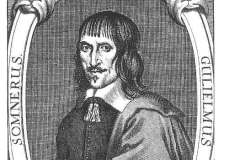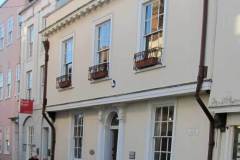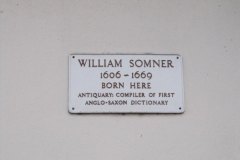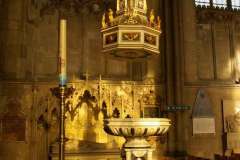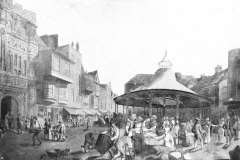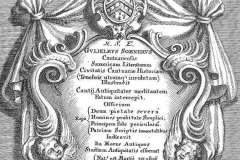Antiquarian, Ecclesistical Lawyer & Writer of the first serious History of Canterbury
William Somner (Image 1) was born in 1598 in the family home at 5 Castle Street (Images 2 and 3), a large timber framed building (known then as the Crown, now as Lullingstone House), and baptized in St Margaret’s church. He lived in this house for the rest of his life. It now bears a simple plaque which oddly refers to his Anglo-Saxon Dictionary but makes no mention of his major contribution to the city’s history – The Antiquities of Canterbury which he published in 1640. Even odder, it seems to get his birth year wrong by eight years (more below under Sources). William’s father, another William and also a lawyer, worked as Proctor to the Canterbury Consistory Court, operating from an office in his home. When William junior left King’s School at thirteen, he followed in his father’s footsteps and was apprenticed as an ecclesiastical lawyer. He learned the trade quickly. By the age of 17 he had qualified as a notary and two years later was preparing the defence of the wife of Sir James Hale when she stood accused of non-attendance at church. He married Elizabeth Turgar from the precincts of the Archbishop’s Palace when he was 28 and they had two daughters Elizabeth and Ann. Two years later he was appointed as Proctor. The Antiquities of Canterbury appeared when William was in his early 40s – widely welcomed but the dedication of the book to his patron Archbishop Laud proved to be unfortunate. Laud was arrested for treason the following year and beheaded four years later. This setback put paid to William’s original plans for a history of the whole county of Kent. When Cromwell’s parliamentary soldiers smashed the cathedral font in 1642, William managed to collect the pieces and hide them. Eighteen years later, with the Commonwealth period at an end, King Charles II returned to England from exile in France, and called at Canterbury. The Mayor was pleased to present him with a bible and gold coins, and William was able to offer the king a copy of his history of Canterbury. In that same year, 1660, William returned the pieces of font to the cathedral, and the elaborate apparatus was re-assembled (Image 4). After the death of his wife Elizabeth, William in 1659 married Barbara Browne, widow of the Master of King’s School. Their first born, another Barbara, was appropriately the first to be baptized in the rebuilt font. In later life William was appointed Master of St John’s Hospital. He completed his Anglo-Saxon Dictionary, mentioned in the tablet on his house, in 1659. William died on 30 March 1669 which fell (according to St Margaret’s baptismal register) on his 61st birthday, or (according to his widow and survivors) on his 53rd (Image 5). The family always believed William to have been born in 1606. Amazingly, the man who had spent much of his professional career preparing and processing wills had not managed to write his own – he dictated it (known as a ‘nuncupative’ will) on the day he died. He was buried in St Margaret’s church where his memorial survives (Image 6) but cannot be seen – it is boxed in to protect it from visitors to the Canterbury Tales exhibition.
William was not the only Somner contributing to Canterbury 17th century life. His brother John was a key figure in the construction of the market hall and theatre at the Christchurch gate in the 1660s, rebuilt in 1790. The market thrived as a selling area for dairy products – hence the name Buttermarket which survives to today. John was also instrumental in persuading Archbishop Juxon to replace the Christchurch gate wooden doors.
Sources: Bateman (1984); Bateman (nd); Gostling (1825); Home (1927) which includes Image 6 above; Oxford Dictionary of National Biography
The disagreement surrounding his birth year (mentioned above) is hard to explain. Click here for additional comments on this oddity.
DL

